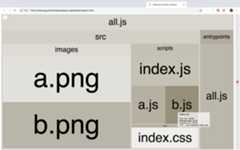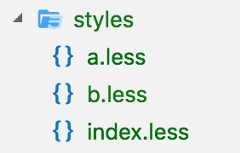Uh oh!
There was an error while loading.Please reload this page.
- Notifications
You must be signed in to change notification settings - Fork503
-
only support js bundle ? |
BetaWas this translation helpful?Give feedback.
All reactions
👍 12
Replies: 19 comments
-
What do you want to see inside a CSS chunk? |
BetaWas this translation helpful?Give feedback.
All reactions
Uh oh!
There was an error while loading.Please reload this page.
Uh oh!
There was an error while loading.Please reload this page.
-
just like the js chunk I guess. the size, the dependencies. don't know whether it's doable. |
BetaWas this translation helpful?Give feedback.
All reactions
👍 41❤️ 12
-
Yeah, I also expected to see all assets that webpack emits, so fonts, images, css, html, js. That way I can get a sense of size and dependencies for all of these things. |
BetaWas this translation helpful?Give feedback.
All reactions
👍 9
-
If someone wants to take a stab at this, it would help a lot. Even a small sample repository using CSS assets / fonts / images what have you would be nice, as then we could discuss how would an output for such a project look like. |
BetaWas this translation helpful?Give feedback.
All reactions
-
@valscion I'll start working on a sample repo with multiple asset inclusion. I assume the plan would be to use that to generate a webpack stats file to write tests for? |
BetaWas this translation helpful?Give feedback.
All reactions
-
Thanks!
Sounds great 👍
I'm not sure how we will end up using the sample repository yet. Writing tests might not be enough, as we will also want to figure out how we'd like the output to be displayed in the generated treemap. So it might need some design iteration first before we write tests |
BetaWas this translation helpful?Give feedback.
All reactions
-
After a bit more investigation I think we can split this up into 2 problems:
The first problem only requires us to find which src asset was turned into which output asset. From there it could be displayed in the visualiser in the correct chunk(s). The second problem requires us to have this mapping for each file. For JS this is done by creating an AST from the output asset, and reverse engineering the webpack bundling process. This won't be possible for styles as they're just concatenated, and this won't let us know where they came from. I agree this needs more design before we move forward, but I'll continue to make a helper-repo that bundles assets in different ways. I've got a couple ideas of how to solve these:
|
BetaWas this translation helpful?Give feedback.
All reactions
-
Would be interesting to see how the output will look like once you get the helper repo in place I'm not sure if the concatenated version would require re-writing all parsing internals |
BetaWas this translation helpful?Give feedback.
All reactions
This comment was marked as spam.
This comment was marked as spam.
Uh oh!
There was an error while loading.Please reload this page.
Uh oh!
There was an error while loading.Please reload this page.
-
Quick repo here that builds scripts, images and styles. (This has index.css importing a.css and b.css)This shows the size of the css asset created, but doesn't show the src files inside, and this suggested feature would solve that. I think I used 'concatenate' badly in the previous comment, and didn't mean concatenated modules. I was trying to say that the output |
BetaWas this translation helpful?Give feedback.
All reactions
👍 9❤️ 2
-
I would love to see a chunked view of my app.css I have over 140 scss files and some of them look deceivingly simple but include a while loops so at a glance they don't look that large. It would also help me to reduce redundant CSS being served. |
BetaWas this translation helpful?Give feedback.
All reactions
-
@iambalaam If you don't use |
BetaWas this translation helpful?Give feedback.
All reactions
-
@yuxizhe is that CSS extracted from Javascript or processed from SCSS? |
BetaWas this translation helpful?Give feedback.
All reactions
Uh oh!
There was an error while loading.Please reload this page.
Uh oh!
There was an error while loading.Please reload this page.
-
@adampatterson I think its maybe webpack
less-loader or sass-loader transform |
BetaWas this translation helpful?Give feedback.
All reactions
Uh oh!
There was an error while loading.Please reload this page.
Uh oh!
There was an error while loading.Please reload this page.
-
bump, i dunno if anyone still cares, just throwing out there that I would find this useful for analyzing a large project full of nested scss imports. in case anyone has found any workarounds, or other tools that might be useful. @yuxizhe's tip about disabling MiniCssExtractPlugin was helpful to get me part of the way there, but it's still a black box in terms of how relative size breaks down within the nested imports beyond the top-level entry point guess i can just use file sizes for now, but it's not really the full picture once compiled FWIW, my use case is trying to identify common-sense places to split a monolithic sass file into split output files, being able to analyze the contributions of each import to the final compiled output would help very easily visually identify these logical split points for now i basically just have to split everything, and then work backwards in terms of re-merging files that are so small that it doesn't make sense for them to be independent. |
BetaWas this translation helpful?Give feedback.
All reactions
👍 1
-
I think analyzing CSS code splitting might be a bit out of scope of this plugin — how CSS is handled can differ so much compared to how JS is handled that the additional maintenance burden on supporting CSS might prove to be too much. I'd be happy to be proven otherwise — if support for CSS analysis can be done in an easy-to-maintain way that can also be optional, I might change my mind. |
BetaWas this translation helpful?Give feedback.
All reactions
👍 2👀 1
-
There is also the matter of purge CSS which is more common now. |
BetaWas this translation helpful?Give feedback.
All reactions
-
I am also looking for such a function. My project has a really large CSS bundle size and I don't which module to optimize. |
BetaWas this translation helpful?Give feedback.
All reactions
👍 3
-
I'm looking for this thing as well. CSS modules compiled by Next.js. |
BetaWas this translation helpful?Give feedback.
All reactions
This discussion was converted from issue #187 on February 23, 2023 08:51.







